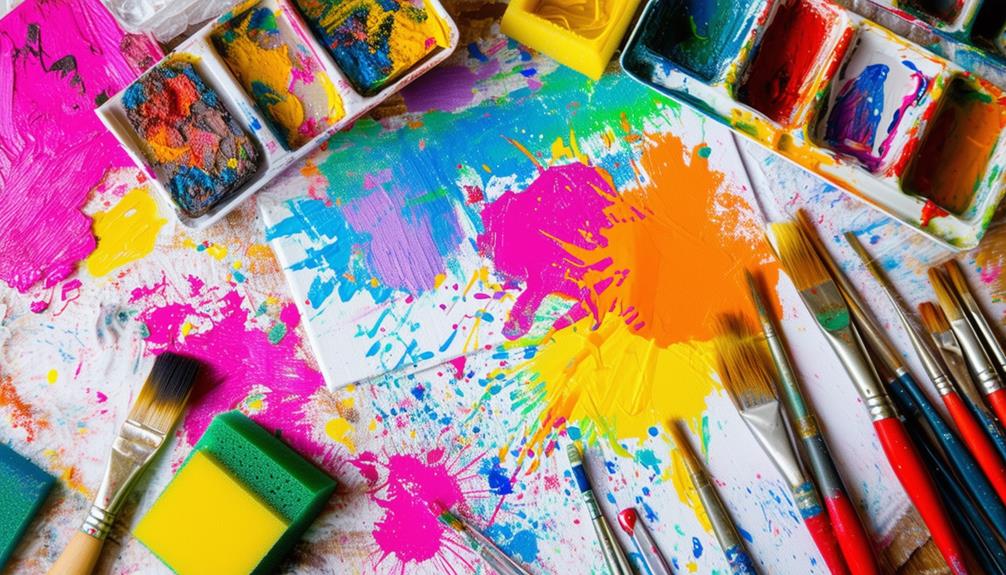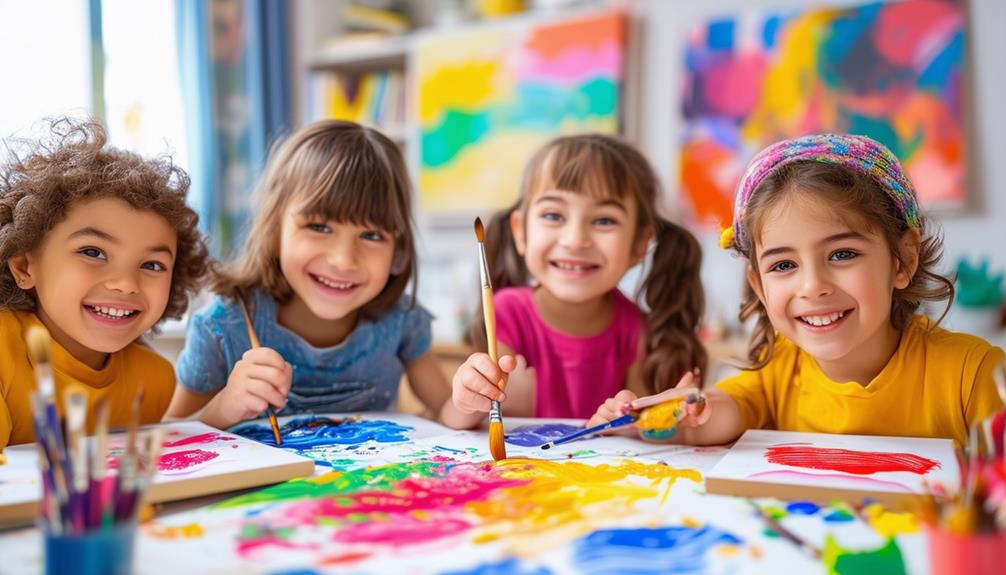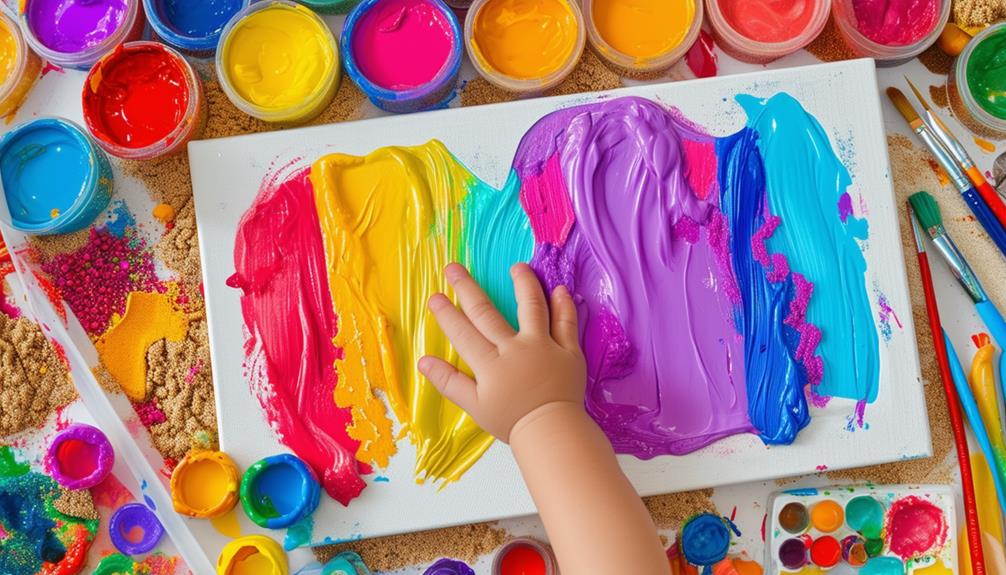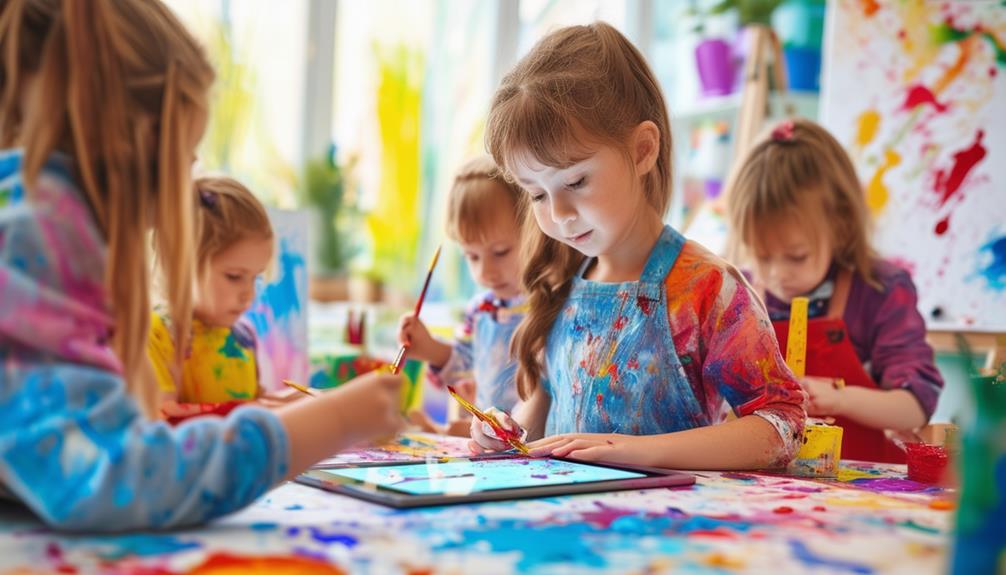Themed Painting Projects: Animals, Space, Underwater, and More
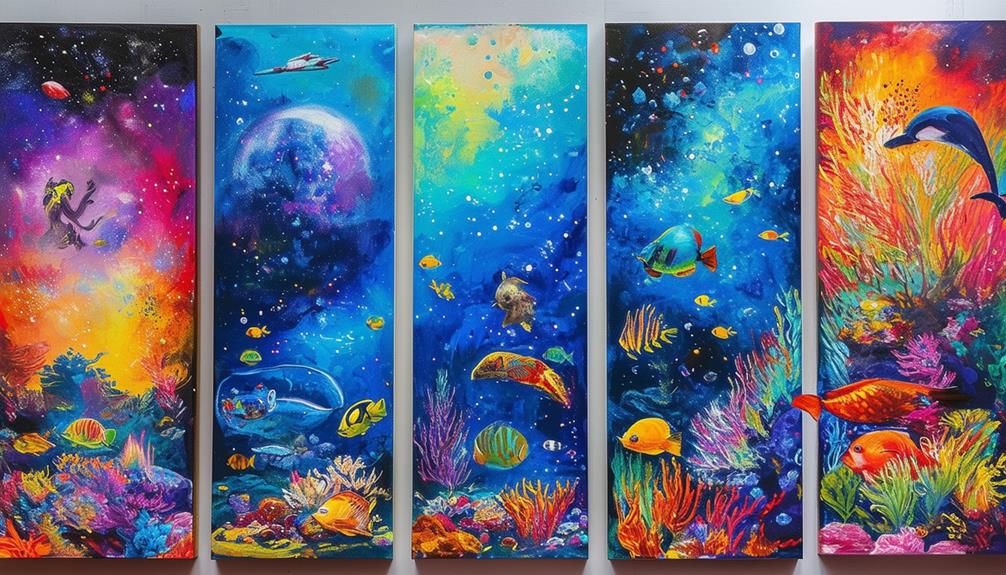
Embarking on themed painting projects opens up a world of creative possibilities, whether you explore the animal kingdom, the vastness of space, or the depths of the ocean. Each theme presents its own unique challenges and rewards, pushing your artistic boundaries and allowing you to discover new techniques and styles. Imagine capturing the grace of a lion, the mysteries of a galaxy, or the vibrant life beneath the sea. These projects are more than just painting; they are an invitation to bring diverse environments to life on canvas. But how do you choose the right theme for your next masterpiece?
Animal-Themed Paintings
Animal-themed paintings capture the beauty and essence of creatures such as elephants, lions, birds, and butterflies. By focusing on these majestic animals, you can explore various art styles, from realistic depictions to abstract or fanciful interpretations. Each style allows you to express different emotions and perspectives, making your work unique.
Imagine painting a fierce lion with bold, vivid colors, or a delicate butterfly with intricate patterns. The possibilities are endless, and the choice is yours. You can even draw inspiration from the sea, incorporating marine animals like dolphins or sea turtles to expand your artistic horizons. The sea's vibrant colors and diverse wildlife can add a dynamic touch to your animal-themed projects.
Through your art, you can tell stories and evoke a sense of connection with the natural world. Whether illustrating the gentle nature of an elephant or the freedom of a soaring bird, your paintings can communicate a deep appreciation for wildlife and the environment. Animal-themed paintings offer a creative outlet to showcase your love for nature and the animal kingdom, bringing the beauty of the wild into your home.
Space-Themed Paintings
To create compelling space-themed paintings, start by depicting celestial landscapes that convey the immensity of the universe. Focus on shading three-dimensional space objects such as planets and stars to add depth and realism. Employ techniques like blending and layering to enhance the lifelike quality of your cosmic scenes.
Creating Celestial Landscapes
Creating celestial landscapes in your paintings allows you to explore the boundless beauty and mystery of the universe. To begin, imagine space as a vast expanse filled with stars and planets. Think of the sky as an endless ocean, rich with wonders that you can capture with paint. Start by choosing vivid colors—deep blues, purples, and blacks for the background. Utilize blending techniques to achieve smooth transitions between these shades, reflecting the infinite nature of space.
To add depth and dimension, experiment with splattering white paint across your canvas to represent distant stars. You can also use sponging to create nebulae and galaxies, giving your scene a complex, layered appearance. Don't hesitate to explore metallic or luminescent paints; they can enhance the brilliance of your celestial bodies and add a surreal quality to your artwork.
Layering elements like planets and moons can evoke a sense of wonder and curiosity. Each brushstroke can bring you closer to the mysteries of the cosmos, sparking your imagination. By focusing on these techniques, you will create stunning celestial landscapes that captivate and inspire creativity.
Shading 3D Space Objects
Mastering the shading of 3D space objects, such as planets and rockets, can significantly enhance the realism and depth of your space-themed artwork. Begin by drawing simple shapes on black paper, as the dark background will amplify your colors and heighten the sense of outer space.
Use oil pastels for their vibrant hues and smooth blending capabilities. Start by identifying your light source to apply basic shading techniques. Use lighter shades where light strikes the object, transitioning to darker shades on the opposite side to create a three-dimensional effect.
Experiment with blending colors to create gradients. For example, blending blues and purples can give a planet a dynamic appearance. Layer the pastels, smudging gently with your fingers or a blending stump, and build up intensity gradually.
Incorporate shadows and highlights to add realism. A well-placed highlight can give a rocket a metallic sheen, while shadows can make a planet appear spherical. Vary the pressure on the oil pastels to achieve different textures and effects, ensuring each space object looks uniquely realistic.
Underwater-Themed Paintings
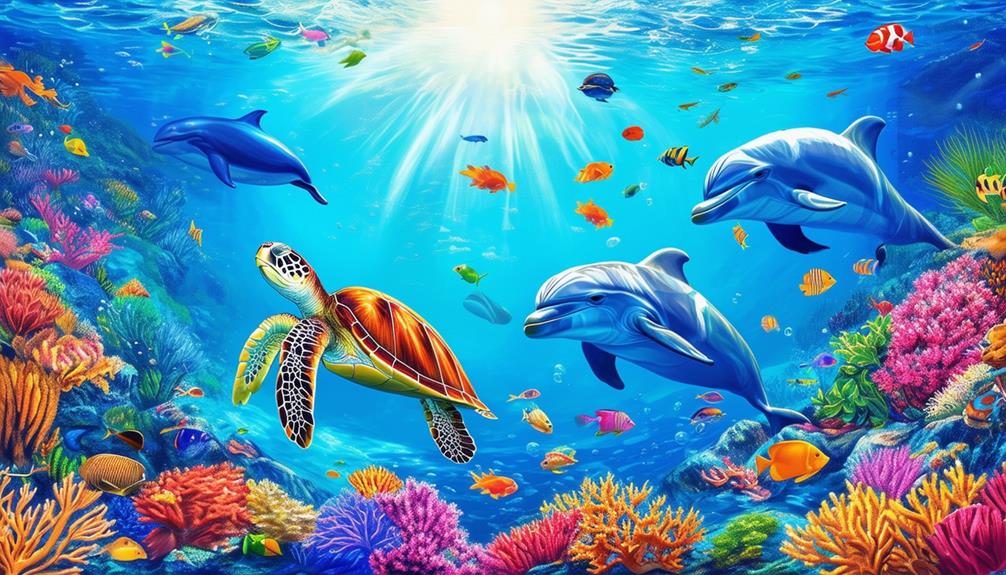
When painting underwater scenes, master ocean layer techniques to create depth and realism. Focus on marine life details, such as the vibrant patterns of fish and coral textures. Use color blending to achieve the perfect mix of blues and greens, bringing your underwater world to life.
Ocean Layer Techniques
To create stunning underwater-themed paintings, you need to master ocean layer techniques using specific colors and texturing tools. This ocean art involves layering different shades to depict the various depths and moods of the sea. Start by understanding the layers of the ocean: the surface, mid-water, and deep ocean. Each layer requires distinct colors to evoke the right feeling.
For the surface layer, use light cerulean and emerald green to mimic the sunlit waters. As you move deeper, incorporate darker azure and pale violets to represent the diminishing light. For the deepest parts, use shades of lavender to capture the mysterious depths.
Enhance your layers with texture. Tools like bubble wrap and sponge rollers can create realistic water patterns and add depth to your painting.
- Feel the tranquility of the sunlit surface with light cerulean and greens.
- Plunge into mystery with darker hues as you explore deeper waters.
- Experience the texture of underwater domains with innovative tools.
- Convey the emotion of the ocean's vastness and mystery.
Mastering ocean layer techniques will make your underwater-themed artworks more immersive and visually captivating.
Marine Life Details
Incorporating intricate details of marine life into your underwater-themed paintings brings the ocean's vibrant ecosystem to life. To capture the essence of marine environments, focus on the diverse creatures inhabiting the oceans, such as colorful fish, majestic whales, playful dolphins, and graceful sea turtles. These details not only make your art more engaging but also educate viewers about the rich biodiversity beneath the waves.
When creating art projects for children, consider including elements like coral reefs, which provide a vivid backdrop and support a wide array of marine species. Encourage children to observe and accurately represent different shapes, sizes, and colors of various species. This approach not only sparks creativity but also fosters an appreciation for marine ecosystems.
Highlighting the challenges marine life faces, such as pollution and habitat destruction, can also be impactful. Through art, you can raise awareness about conservation efforts and the importance of sustainable practices. When children understand these issues, they are more likely to become advocates for marine protection.
Color Blending Tips
Mastering color mixing techniques can transform your underwater-themed paintings into vibrant and enchanting ocean scenes. One crucial technique in watercolor art is the wet-on-wet method, where you apply moist paint onto a damp surface. This approach allows colors to blend seamlessly, mimicking the fluidity of water. Experimenting with layering translucent colors can add depth and dimension, making your ocean scenes come alive with subtle gradients and shadows.
When creating underwater-themed paintings, consider using a restricted color palette to maintain harmony and unity in your artwork. Blending colors with a dry brush technique can introduce a textured and natural feel, perfect for depicting coral reefs or underwater flora.
Understanding color theory is fundamental. Knowing how colors interact can help you achieve realistic and captivating underwater blends. Here's what you can evoke in your audience:
- A sense of calmness: Soft blues and greens blending together.
- Enigma: Deep, layered shades creating the ocean's depths.
- Thrill: Bright, contrasting hues portraying vibrant sea life.
- Amazement: Smooth transitions that capture the play of light underwater.
These tips will enhance your underwater-themed watercolor art, bringing your ocean visions to life.
Jungle-Themed Paintings
Jungle-themed paintings come alive with vibrant colors and intricate details, instantly immersing you in an exotic, untamed world. While the jungle is filled with diverse wildlife, some artists also draw inspiration from sea creatures to create more surreal and imaginative scenes. Picture a canvas where tropical birds share space with octopuses and jellyfish, merging the richness of the jungle with the mystique of the ocean.
To capture the essence of a jungle environment, focus on elements like wild animals, dense foliage, and cascading waterfalls. Techniques such as layering colors and creating depth with shadows and highlights will make these elements pop. Adding texture with various brush strokes can enhance realism further.
Jungle paintings often evoke a sense of adventure, mystery, and wonder, transporting you to exotic locales filled with untamed beauty and hidden treasures. Exploring the diverse flora and fauna of the jungle through your art can inspire creativity and foster a deeper appreciation for nature. So, grab your brushes and let the vibrant jungle come alive on your canvas!
Desert-Themed Paintings
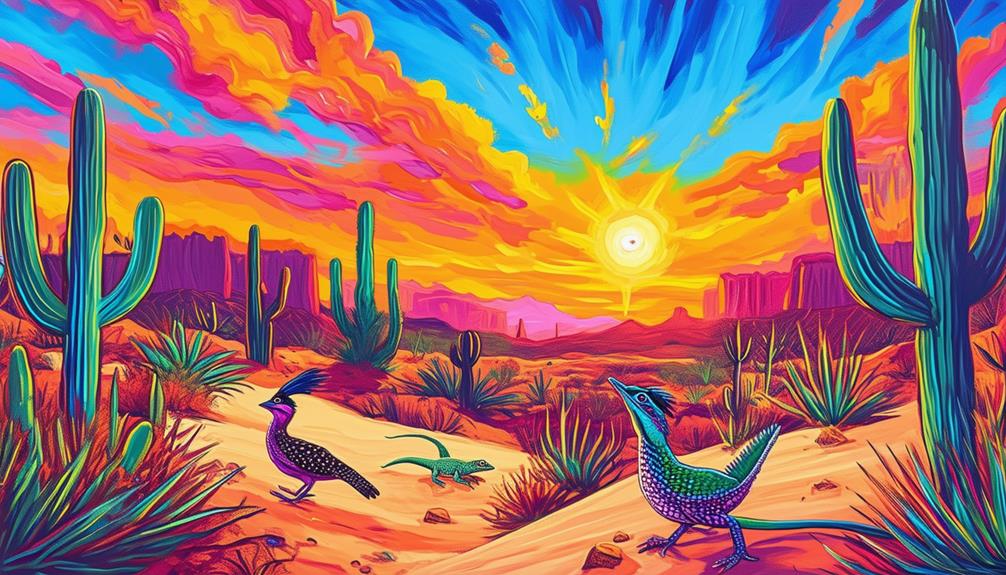
When exploring desert-themed paintings, mastering techniques for desert landscapes, creating cactus art projects, and capturing sand dune textures are essential. Start by using warm earth tones to highlight the arid beauty of the desert. Then, focus on the distinct forms of cacti and the flowing lines of sand dunes to make your artwork come alive.
Desert Landscape Techniques
Creating a realistic desert landscape requires mastering earthy tones and texture techniques to depict the arid environment accurately. Immerse yourself in a warm palette of burnt sienna, ochre, and other earth tones to bring the desert to life. These colors capture the essence of the parched land and the intense heat of the sun.
Experiment with brushstrokes to convey the rugged terrain and sparse vegetation typical of desert landscapes. Vary your brush techniques to highlight the different textures found in the desert, from smooth sand dunes to rough, rocky outcrops. Study the play of light and shadow to add depth and dimension, making your painting truly evocative.
To evoke emotion in your audience, consider these elements:
- Isolation: Show vast, empty expanses to convey solitude.
- Heat: Use warm colors to give a sense of blistering temperatures.
- Mystery: Include shadows and distant objects, sparking curiosity.
- Resilience: Depict hardy plants or rocks standing strong against the harsh environment.
Cactus Art Projects
After mastering the earthy tones and textures of desert landscapes, let's turn our focus to the vibrant and distinctive succulents that thrive in these arid environments. Cactus art projects provide an excellent opportunity to delve deeper into desert-themed paintings, offering a canvas to showcase these resilient plants. This engaging activity not only allows you to experiment with bright colors and geometric shapes but also encourages the exploration of different textures and techniques to make your cacti stand out.
When planning your lesson, begin by studying the diverse forms and colors of various cacti species. This will give you a solid foundation for your painting. Use bold, vibrant colors to capture the unique beauty of cactus flowers and the lush greens of their stems. Techniques like stippling or dry brushing can add texture and depth to your artwork.
Cactus art projects are perfect for highlighting themes of resilience and adaptability. As you paint, consider how these qualities are embodied by cacti surviving in harsh desert conditions. This perspective can add a deeper meaning to your work. So, grab your brushes and paints, and immerse yourself in the fascinating world of cactus art!
Sand Dune Textures
Sand dune textures enhance your desert-themed paintings by adding depth and realism. They create a sense of movement and shifting sands, making your artwork dynamic and immersive. Techniques like dry brushing and stippling help replicate the intricate patterns and delicate grains of sand.
Light and shadow play a crucial role in highlighting sand dune textures. By strategically placing highlights and shadows, you can accentuate the undulating shapes and natural formations of the dunes. Using a variety of shades in yellow, brown, and beige will further enrich the authenticity of your textures, making them appear more natural and lifelike.
When painting desert landscapes, consider the emotions you want to evoke:
- Solitude: The vast, empty expanse of dunes can evoke feelings of isolation.
- Exploration: Imagine adventurers trekking through the shifting sands.
- Mystery: Envision hidden treasures buried beneath the dunes.
- Tranquility: The gentle curves of the dunes can create a sense of peace.
Incorporate these elements to make your desert-themed paintings as captivating as those featuring sea creatures or marine life.
Forest-Themed Paintings
Forest-themed paintings capture the lush beauty and serene atmosphere of nature with vibrant colors and intricate details. These artworks often feature green trees, diverse wildlife, and peaceful landscapes, making them an excellent way to teach children about the wonders of nature. Through creating forest-themed paintings, kids learn to appreciate the intricate details of trees, the play of sunlight filtering through leaves, and the vibrant array of foliage. This artistic activity hones their observational skills and instills a sense of tranquility and connection to the natural world.
Artists can choose from different mediums like acrylics, watercolors, or oils when creating forest-themed paintings. Each technique highlights unique aspects of the forest's beauty. For instance, watercolors can capture the delicate, ethereal quality of sunlight piercing through the canopy, while acrylics emphasize the rich, bold colors of autumn leaves.
Whether inspired by real forests or fantastical woodland scenes, these paintings evoke feelings of peace and wonder. They remind us of nature's beauty and the serenity it offers, making forest-themed paintings a delightful and enriching project for artists of all ages.
Mythical Creatures Paintings
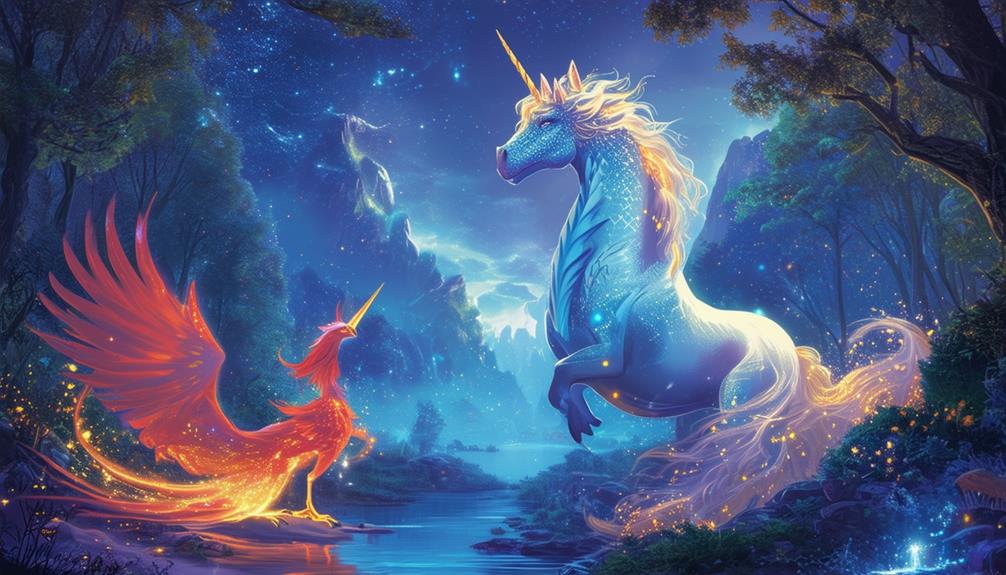
Mythical creatures paintings ignite the imagination with fantastical beings such as dragons, unicorns, and mermaids. These artworks delve into folklore, legends, and stories from diverse cultures, making each piece distinctive and enchanting.
When engaging with mythical creatures paintings, you're not merely creating art; you're invoking a sense of magic and wonder. Envision a dragon soaring above a fiery landscape or a unicorn trotting through a mystical forest. Imagine the vibrant colors and intricate details, similar to the dazzling hues of a coral reef.
What makes mythical creatures paintings unique:
- Creativity: Freedom to experiment with unique colors, shapes, and textures.
- Imagination: Transport viewers to realms brimming with magic and intrigue.
- Cultural Stories: Draw inspiration from global folklore and legends.
- Emotion: Evoke feelings of wonder, curiosity, and excitement.
Incorporate these elements into your next art lesson and watch your canvas transform into a portal to fantastical worlds. Embrace the challenge and let your creativity soar!
Farm Animals Paintings
Farm animal paintings capture the essence of rural life, bringing the charm of the countryside into your home. These delightful artworks typically feature cows, pigs, chickens, and sheep in vibrant rural settings. Artists often use lively colors to depict the joyful and heartwarming aspects of farm animals, making them perfect for farmhouse or rustic-themed interiors.
If you're looking for crafts for kids, farm animal paintings are a fantastic option. They're simple yet engaging projects that children will love. Start by drawing basic shapes of animals—a circle for the body, smaller circles for the head and limbs. Then, let your kids bring these animals to life with colors. To add a fun twist, use white tempera paint for the sheep's wool or a cow's spots. It creates a textured, realistic look that kids find exciting.
Common themes include barns, pastures, and sprawling farm landscapes, which evoke feelings of nostalgia and simplicity. These paintings aren't just decor; they're a way to preserve and celebrate the tranquility of rural life. So grab your brushes and let your creativity roam free on the canvas, capturing the spirit of the countryside.
Night Sky Paintings
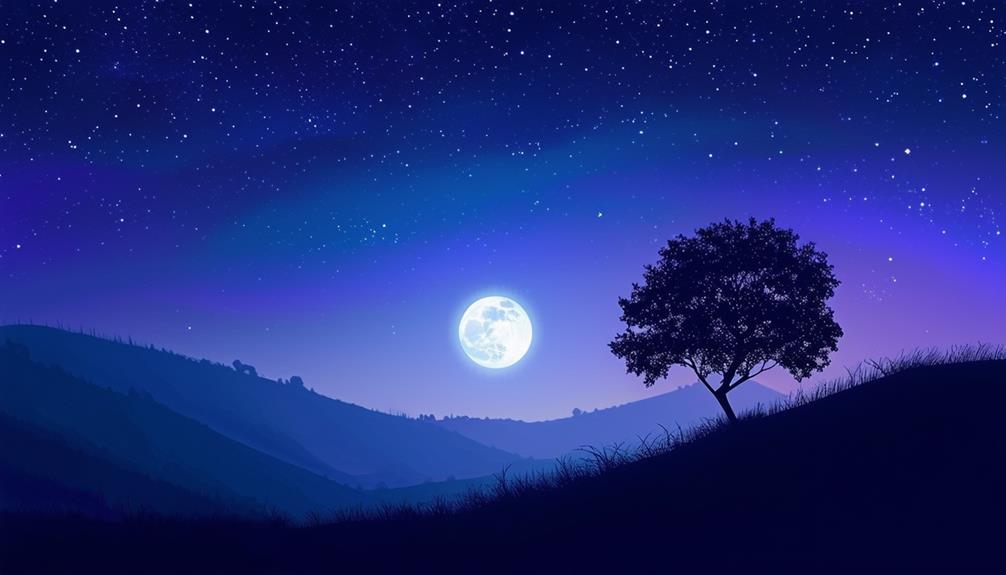
Night sky paintings captivate the imagination with their stunning depictions of stars, galaxies, and celestial wonders. When students create these awe-inspiring artworks, they often use oil pastels to bring the night sky to life. Oil pastels are perfect for blending colors and creating the rich textures that make these paintings truly mesmerizing. To evoke the depth and mystery of the night sky, artists typically rely on shades of dark blues, purples, and blacks.
Imagine a canvas where:
- Stars twinkle against a backdrop of endless space.
- Planets appear with their rings and moons in orbit.
- Galaxies swirl in vibrant, intricate patterns.
- Celestial events like meteor showers light up the night.
Using oil pastels, you can easily blend colors to create the soft gradients of twilight or the stark contrast of a moonlit landscape. These techniques add layers of depth, making the scene feel almost three-dimensional. By incorporating elements like meteor showers or the aurora borealis, you can infuse your painting with dynamic energy and movement. The result is a piece that not only captures the vastness of space but also evokes a sense of wonder and tranquility.
Abstract Nature Paintings
From the awe-inspiring vastness of space, let's shift our focus to the vibrant world of abstract nature paintings, where artists capture the essence of natural elements through imaginative interpretations. These artworks transcend mere replication, delving deeper to express the beauty and complexity of the environment using vibrant colors and intricate textures.
In abstract nature paintings, colors play a vital role. Artists explore a broad spectrum of hues to evoke specific emotions or highlight particular aspects of their subjects. Picture a forest scene brought to life with bold greens and calming blues, or a desert landscape depicted with warm, fiery reds and oranges. The use of color can transform a simple landscape into a dynamic and evocative piece of art.
Textures are equally significant in these paintings. Artists experiment with various techniques to create depth and tactile qualities, whether it's the roughness of bark, the softness of leaves, or the fluidity of water. By focusing on textures, they can make their artworks feel more alive and engaging.
Through abstract nature paintings, you'll find a unique way to appreciate biodiversity and the natural world's beauty. These pieces are not just visually compelling; they tell stories and convey deep connections to nature.

